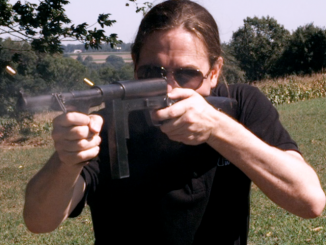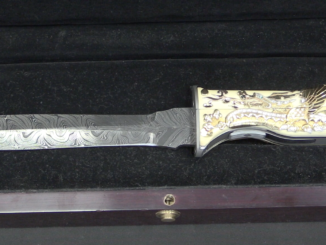These are lots #1477 (Model 1909) and #1475 (Model 1910) in the upcoming RIA Premier Auction. It was scheduled for April, but has been postponed – check their web site for upcoming Online Only auctions every month, though!
Even while the field trials of the Colt 1907 were ongoing, John Browning was improving his pistol. With the Model 1909 he designed the single-link barrel system that would prove to be the core of the final 1911 design. The 1909 model also included an enlarged grip safety, a slide release integrated with the barrel link pin, a new magazine release button that could be operated with one hand, and the firing pin retention plate. It wasn’t quite sufficient, however, and was closely followed by the Model 1910.
It was in the 1910 that Colt and Browning revised the grip angle from the quite square 1900/1902/1905/1907/1909 style to the more steely angled pattern we recognize form the 1911. The 1910 model also added the internal extractor, combined the mainsprings into a single three-finger piece, and improved the ejector. It would be modified to also include a thumb safety, to allow safe reholstering. The first major test of the 1910 against the Savage .45 took place on November 10, 1910, and while the Colt/Browning pistol was the better of the two, it had 15 malfunctions and four broken parts in the 6,000 round endurance test. Neither it nor the Savage were deemed acceptable, and a second test was scheduled for March 15, 1911.
It was in that March of 1911 test that the Colt/Browning passed the endurance test with no failures of any kind – a very remarkable achievement. The Savage was still suffering significant problems, and Colt was declared the winner, with the pistol to be adopted as the Model of 1911.




“…more steely angled pattern …”? But the whole gun is steely, except for the grips. Oh, steeply.
I don’t think the reason for switching to the single-link system has been mentioned — on the double-link system, links kept breaking. (There was competition between the links that would eventually overstress one of them?) One of our engineer viewers might explain the real cause.
Nice to see this progression. So few inventions work perfectly in their first iterations.
The cause might be the necessity to change the slide take off from the front as ending the very dangerous previous application from the back.,. Direct to the shooter’s face if locking bar being broken… lMHO…
I wonder how much influence the Luger grip angle had on the 1911 prototype? Did the use testers try out the Luger, and go “Man, if only…”?
“Users of the 1892 revolver.”
This explains a lot… 😉
I’ve been trying to understand for a long time why there was a transition from the optimal angle of the handle to the idiot, which has survived until today?
It’s good that they didn’t think of fitting a brush to clean the horses with the gun. LOL
No Ian.Perfection didn’t occur until 1935…Grand Puissance Forever!!
sir:
i’ve owned both. one model of 35, and 4 1911’s. i still have 2 1911’s, and a ruger ec9s. i vote 1911, combat commander. “old slabsides” is not so much to look at, but transforms into a thing of beauty in the hand.
p.s. i like the thumb safety, don’t mind the grip safety, and my commander style is chambered in 9x23mm winchester. a very handy, and accurate pistol. and, i think the “swinging link,” if properly installed, is a thing of genius. from an engineering standpoint, you always know “where things are located” with the swinging link, it is very precise.
So, if I count it right – five evolutionary models before final one. What to think about it? Probably lots of tinkering by this skillful mechanic. For whatever we have a ready reference, he had to work out step by step. The kinematic solution on tilting barrel at rear only in particular was courageous step. I wonder, did he make some sort of scaled up layouts for that? He had to determine required clearance in barrel bushing, right? Are there any documents in his museum/ library to indicate that kind of work?
His psyche is also interesting to read: he was ready to offer a fix before problem happened. That is designer worth of the name.
Luger’s grip angle is at least 30deg (measured from vertical). This (the front contour), in my estimation is only about half of that. More the grip is laid, longer the magazine ends up to be.
The Luger also had a magazine release behind the trigger guard, very similar. Lots of influences possible.
The Borchardt had the magazine release behind the trigger in 1893! Luger kept it, the US Army was perfectly aware of it, and knew it was a viable change to request of Browning and Colt.
Speaking of iterations, if you count all of Browning’s blowback pocket pistols as one series from 1899 to 1910, you will see the progression of pivoting striker to hammer to in-line striker, recoil spring above, below and around the barrel, grip safety or not, and calibers both larger and smaller than .32/7.65. An inspection of all his patents put together, projects built and unbuilt, show his ability and willingness to take many themes and run with them in any direction.
An inspection of his patents shows that he had the opportunity to build any, even frankly curious projects that he himself considered promising. Some of the mountains of his projects turned out to be really worthwhile.
And most importantly, he could do this without the participation of authorized leading idiots.
Lucky, although not always so lucky.
These are lots #1477 (Model 1909) and #1475 (Model 1910) in the upcoming RIA Premier Auction. It was scheduled for April, but has been postponed – check their web site for upcoming Online Only auctions every month, though!